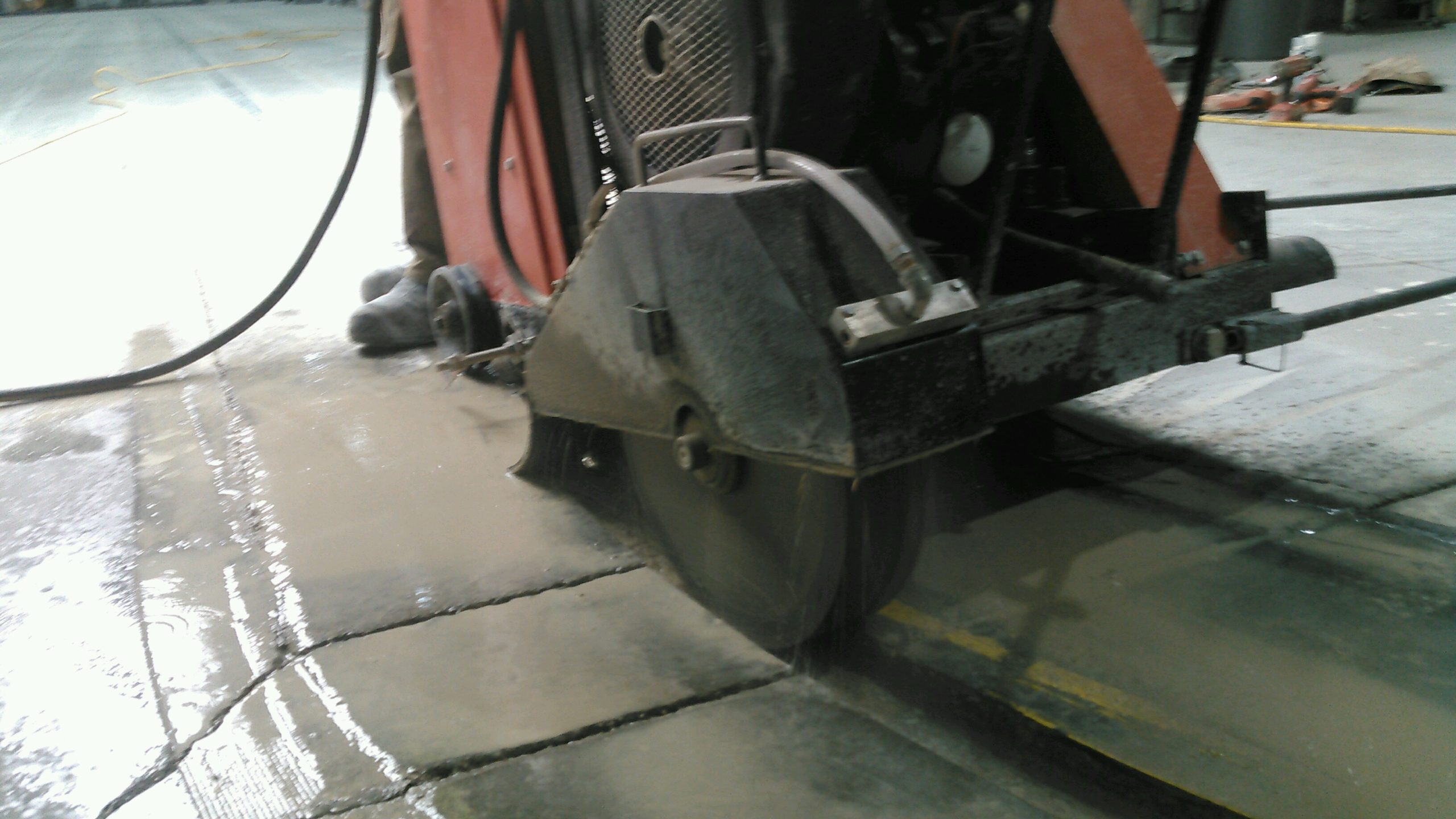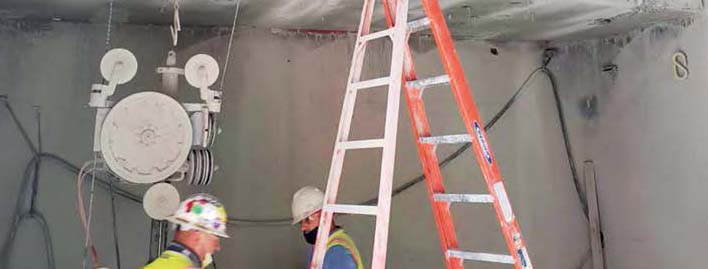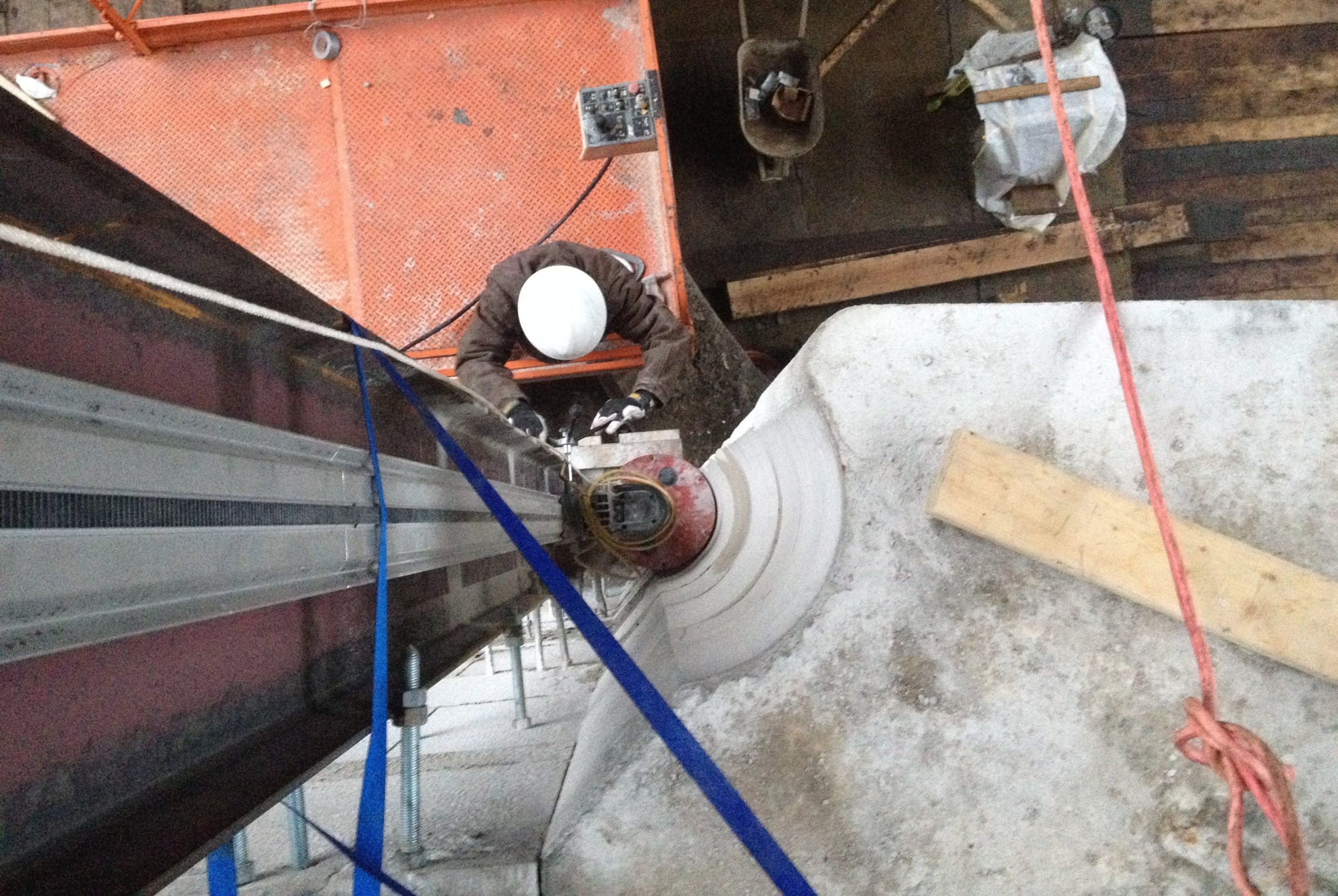
Ahead of the Curve

Radial Cutting Techniques Refurbish Factory Floor
Employees at a plastics manufacturing facility were getting that sinking feeling. Shortly after operations were expanded at the facility, owners found that the increased volume of material carts being moved around the factory floor on steel rollers had caused grooves to form in the concrete along the carts’ main travel routes. This led to navigation problems with the carts and a reduced amount of control over their movements. A CSDA member was contracted to perform over 1,100 feet of slab saw milling, including sections of radial cuts, to help refurbish and reinforce the floor.
Continental Structural Plastics was founded in 1969 as a plastics manufacturer supplying compression molding components to the automotive industry. Today, the company’s products have replaced steel and aluminum in many applications, offering superior strength-to-weight ratios for customers looking to reduce weight and increase fuel efficiency. It has several locations across the U.S. and has operations in China, France and Mexico. It was at the company’s Carey, Ohio location where excessive wear of the factory floor had become an issue.

A modified 65-horsepower saw was used to create slots in the concrete for reinforcing steel bearing plates.
General contractor Clouse Construction Corp. of New Riegel, Ohio was tasked with refurbishing the floor and finding a solution that would stop grooves from forming on the new surface. The plan was to install lengths of 4-inch-wide, 0.25-inch-thick steel bearing plates in the floor areas where the grooves had appeared. Clouse Construction approached CSDA member Precision Concrete Cutting of Carey to create the required slots to house the bearing plates. With just two days allocated to complete the refurbishment, the cutting contractor got to work.
“Our relationship with Clouse has been built over the 19 years our companies have worked together,” said Matt Leightey, owner of Precision Concrete Cutting of Carey. “When we were approached with this project, I knew we could do the straight milling and had the confidence we could step up and figure out a way to make the radial cuts.”

The contractor set 18 diamond blades with spacers on the blade shaft to make 4-inch-wide slots to a depth of 0.25 inch.
The work consisted of milling 1,026 feet of 0.25-inch-deep and 4-inch-wide slots in the concrete floor slab. This formed two tracks that ran parallel around the factory floor spaced 50 inches apart. The cutting contractor also had to complete an 11-foot radius groove and a 7-foot radius groove the same width and thickness, then one 9-foot radius groove to a depth of 1 inch with a 5-inch width.
Due to the limited time available to complete the project, which was scheduled over the Easter weekend, and the tolerance of the plates to be installed, fast and precise sawing with diamond tools was chosen as the preferred method to accomplish the task.
Alternative methods, involving the removal of portions of the floor to re-pour the concrete with plates embedded, were considered but soon abandoned due to time constraints. Grinding the grooves in was also considered but abandoned, as there was not enough accuracy to grind a straight groove for several hundred feet in multiple areas.
The team from Precision set up on the jobsite on Good Friday. A 65-horsepower Clipper slab saw was fitted with 18 blades with spacers on a modified blade shaft. All blades were 18 inches in diameter and 0.187 inch thick. The saw had been previously modified to cut “rumble strips” on rural roads to alert drivers of dangerous intersections. To complete the specified requirements for this job, a new blade shaft was designed to accommodate for 4-inch-wide cutting. This also meant fabricating a blade guard with enhanced water distribution to suppress dust and reconfiguring the outdated transmission. Therefore, Precision already had a suitable tool for the project. What the cutting contractor didn’t have, however, was the ability to turn the saw on a tight radius while maintaining the 4-inch width and 0.25-inch depth required by that the general contractor. By attaching a pivot point to the saw, operators were able to achieve the desired effect: 7-, 9- and 11-foot radius cuts.
When first attempting to attach a pivot point to the saw, Precision did so as close to the blade shaft as possible. It was found that, when pivoting, the saw had a dog tracking affect that would have resulted in the cut being wider than the desired 4 inches. By attaching a second pivot point to the rear of the saw, the contractor was able to swing the radius with minimal effort and gain the accuracy of the cut desired.

Over 1,100 feet of concrete milling was completed to form the new slots.
At the start of the cutting process, it was also discovered that the rear tire of the saw was going to drop into the milled area. To resolve this issue, Precision attached a bogey wheel to the rear of the saw that would support the weight of the saw when the drive wheel was over the radius cut. This caused minimal down time, as the contractor’s shop was located within a mile of the jobsite and there were parts and tooling in house to resolve this issue.
During the milling process, operators wore the appropriate PPE and dust was suppressed by the use of wet cutting techniques. Slurry was collected by wet vacuums and disposed of offsite. By the end of the work, Precision had completed 1,026 feet of 4-inch-wide straight line milling, 69 feet of 0.25-inch-deep radius milling and a further 35 feet of 1-inch-deep radius milling. All slurry and concrete debris was removed as the work progressed, so the team from Precision finished the job in 10 hours. Leightey was very pleased with the result.
“By completing our part of the project in one working day, and placing the project a full day ahead of schedule, all involved were able to spend Easter Sunday at home with family members. I couldn’t have been more proud of the outcome of the project. All plates, including the radius sections that were fabricated at a local machine shop offsite and delivered that day, fell into place with no issues,” he stated.
The innovation and dedication shown by this professional concrete cutter allowed the work to be completed ahead of schedule and meant Continental Structural Plastics could operate as usual after the Easter weekend. This is another example of how CSDA members are always ahead of the curve!
Company Profile
Precision Concrete Cutting of Carey has been a CSDA member for 13 years and was established in 1997. The company is based in Carey, Ohio and has four trucks and seven employees. Precision Concrete Cutting of Carey offers the concrete cutting services of flat sawing, core drilling, wall sawing, hand sawing, curb sawing, scarifying and surface grinding. We specialize in waste water treatment facilities and rural bridge reconstruction.
Resources
General Contractor:
Clouse Construction Corp.
Sawing and Drilling Contractor:
Precision Concrete Cutting of Carey
Carey, Ohio
Phone: 419-396-3331
Email: matt@pccutting.com
www.precisionofcarey.com
Methods Used: Slab Sawing














